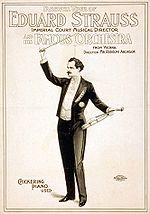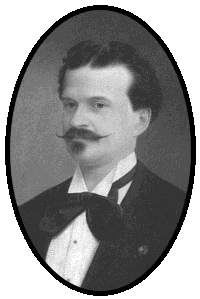
Eduard Strauss
Encyclopedia

Austria
Austria , officially the Republic of Austria , is a landlocked country of roughly 8.4 million people in Central Europe. It is bordered by the Czech Republic and Germany to the north, Slovakia and Hungary to the east, Slovenia and Italy to the south, and Switzerland and Liechtenstein to the...
n composer
Composer
A composer is a person who creates music, either by musical notation or oral tradition, for interpretation and performance, or through direct manipulation of sonic material through electronic media...
who, together with brothers Johann Strauss II
Johann Strauss II
Johann Strauss II , also known as Johann Baptist Strauss or Johann Strauss, Jr., the Younger, or the Son , was an Austrian composer of light music, particularly dance music and operettas. He composed over 500 waltzes, polkas, quadrilles, and other types of dance music, as well as several operettas...
and Josef Strauss
Josef Strauss
Josef Strauss was an Austrian composer.He was born in Vienna, the son of Johann Strauss I and Maria Anna Streim, and brother of Johann Strauss II and Eduard Strauss. His father wanted him to choose a career in the Austrian Habsburg military...
made up the Strauss musical dynasty. The family dominated the Viennese
Vienna
Vienna is the capital and largest city of the Republic of Austria and one of the nine states of Austria. Vienna is Austria's primary city, with a population of about 1.723 million , and is by far the largest city in Austria, as well as its cultural, economic, and political centre...
light music
Light music
Light music is a generic term applied to a mainly British musical style of "light" orchestral music, which originated in the 19th century and had its heyday during the early to mid part of the 20th century, although arguably it lasts to the present day....
world for decades, creating many waltz
Waltz
The waltz is a ballroom and folk dance in time, performed primarily in closed position.- History :There are several references to a sliding or gliding dance,- a waltz, from the 16th century including the representations of the printer H.S. Beheim...
es and polka
Polka
The polka is a Central European dance and also a genre of dance music familiar throughout Europe and the Americas. It originated in the middle of the 19th century in Bohemia...
s for many Austria
Austria
Austria , officially the Republic of Austria , is a landlocked country of roughly 8.4 million people in Central Europe. It is bordered by the Czech Republic and Germany to the north, Slovakia and Hungary to the east, Slovenia and Italy to the south, and Switzerland and Liechtenstein to the...
n nobility as well as dance-music enthusiasts around Europe. He was affectionately known in his family as 'Edi'.
Life and music
Eduard Strauss' style was individual and did not attempt to emulate the works of his other brothers or his contemporaries. But he was primarily remembered and recognized as a dance music conductorConducting
Conducting is the art of directing a musical performance by way of visible gestures. The primary duties of the conductor are to unify performers, set the tempo, execute clear preparations and beats, and to listen critically and shape the sound of the ensemble...
rather than as a major composer in the Strauss family, and his popularity was overshadowed by that of his elder brothers. Realising this, he stamped his own mark with the quick polka, known in German as the "polka-schnell". Among the more popular polkas that he ever penned for the Strauss Orchestra, which he continued to conduct until its disbandment on 13 February 1901, were "Bahn Frei", op. 45, "Ausser Rand und Band", op.168, and "Ohne Bremse", op. 238. He also found time to pen a few lovely waltzes, of which only a handful survived obscurity. The most famous is probably the "Doctrinen", op.79.
Strauss' musical career was pervaded with rivalry not only from his brothers, but also from the military bandmaster and dance music composer Karl Michael Ziehrer
Karl Michael Ziehrer
Karl Michael Ziehrer was an Austrian composer. In his lifetime, he was one of the fiercest rivals of the Strauss family; most notably Johann Strauss II and Eduard Strauss....
, who even formed a rival orchestra called "Formerly Eduard Strauss Orchestra", and began giving concerts in Vienna
Vienna
Vienna is the capital and largest city of the Republic of Austria and one of the nine states of Austria. Vienna is Austria's primary city, with a population of about 1.723 million , and is by far the largest city in Austria, as well as its cultural, economic, and political centre...
under this new title. Eduard Strauss successfully filed a court action against Ziehrer for the improper and misleading use of his name, but Ziehrer would eventually surpass the Strauss family in popularity in Vienna
Vienna
Vienna is the capital and largest city of the Republic of Austria and one of the nine states of Austria. Vienna is Austria's primary city, with a population of about 1.723 million , and is by far the largest city in Austria, as well as its cultural, economic, and political centre...
, particularly after the deaths of his more talented brothers, Johann Strauss II and Josef Strauss. Their rivalry was to extend until the Strauss Orchestra was disbanded.
Strauss married Maria Klenkhart on 8 January 1863 and had two sons, Johann Strauss III
Johann Strauss III
Johann Strauss III was an Austrian composer whose father was Eduard Strauss, whose uncles were Johann Strauss II & Josef Strauss, and whose grandfather was Johann Strauss I...
and Josef Eduard Strauss. The eldest son, Johann Strauss III, was to lead the Strauss revival well into the 20th century.
However, personal setbacks in the 1890s, such as the death of brother Johann Strauss II
Johann Strauss II
Johann Strauss II , also known as Johann Baptist Strauss or Johann Strauss, Jr., the Younger, or the Son , was an Austrian composer of light music, particularly dance music and operettas. He composed over 500 waltzes, polkas, quadrilles, and other types of dance music, as well as several operettas...
in 1899, and his realization that his immediate family had squandered his personal fortune, led Eduard Strauss to decide on retirement. Eduard Strauss engaged in the final tour of his musical career to North America
North America
North America is a continent wholly within the Northern Hemisphere and almost wholly within the Western Hemisphere. It is also considered a northern subcontinent of the Americas...
in 1899 and in 1901, disbanded the Strauss Orchestra, and returned to Vienna
Vienna
Vienna is the capital and largest city of the Republic of Austria and one of the nine states of Austria. Vienna is Austria's primary city, with a population of about 1.723 million , and is by far the largest city in Austria, as well as its cultural, economic, and political centre...
where he died in 1916. He retired from public life and never actively took part in any public musical activity, although he did document his family memoirs titled Erinnerungen in 1906. He is buried in Zentralfriedhof
Zentralfriedhof
The Zentralfriedhof is one of the largest cemeteries in the world, largest by number of interred in Europe and most famous cemetery among Vienna's nearly 50 cemeteries.-Name and location:...
cemetery.
Since 1825, the Strauss Orchestra Archives collected the compositions of not only Eduard, but of Johann II and the rest of the Strauss family. In 1907, Eduard instructed that the archives be burned. Eighty years later, conductors Alfred Walker and Klaus Heymann managed to put together a semi-complete collection of Johann's works (according to Johann Strauss II: The Complete Orchestral Edition).
Works of Eduard Strauss

- Ideal Polka-française op. 1 (1863)
- Bahn Frei! ('Clear the Track!') Polka-schnell op.45
- In Künstlerkreisen ('In Artistic Circles') Polka-française op. 47
- Mit Dampf! ('Steam Up!') Polka-schnell op.70
- Auf und Davon! ('Up and Away!') Polka-schnell op.73
- Fesche Geister ('Fresh Spirit') waltz op. 75
- Doctrinen ('Doctrines') waltz op. 79
- Interpretationen ('Interpretations') waltz op.97
- Ohne Aufenthalt ('Without Stopping!') Polka-schnell op.112
- Carmen-Quadrille (with themes from Georges BizetGeorges BizetGeorges Bizet formally Alexandre César Léopold Bizet, was a French composer, mainly of operas. In a career cut short by his early death, he achieved few successes before his final work, Carmen, became one of the most popular and frequently performed works in the entire opera repertory.During a...
's CarmenCarmenCarmen is a French opéra comique by Georges Bizet. The libretto is by Henri Meilhac and Ludovic Halévy, based on the novella of the same title by Prosper Mérimée, first published in 1845, itself possibly influenced by the narrative poem The Gypsies by Alexander Pushkin...
) op.134 - Das Leben ist doch Schön ('The Life is So Beautiful') waltz op.150
- Leuchtkäferln waltz op.161
- Ausser Rand und Band ('Out of Control') Polka-Schnell op.168
- Krone und Schleier ('Crown and Veil') waltz op.200
- Mit Chic! ('With Style') Polka-schnell op.221
- Mit Vergnügen! ('With Pleasure!') Polka-schnell op.228
- Ohne Bremse ('Without Brakes') Polka-schnell op.238
- Mit Extrapost ('Posthaste') Polka-schnell op.259
- Blüthenkranz Johann Strauss'scher Walzer in Chronologischer Reihenfolge von 1844 bis auf die Neuzeit ('Bouquet of Johann Strauss' Waltzes in Chronological Order from 1844 to Present Time') (1894)
Works with Strauss brothers
- Trifoilen waltz, ('Trifles') (with Johann II and Josef Strauss) (1865)
- Schützen quadrille, ('Sharpshooter') (with Johann II and Josef Strauss) (1866)

